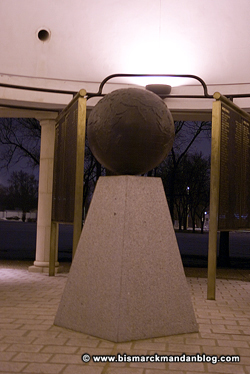
It’s official: May’s Camera is gone. After a run of nearly 40 years, they recently closed their doors, adding yet another blank storefront to the plagued downtown area of Bismarck. It’s always sad to see the closure of a homegrown business with a long legacy…but, that said, I had only been in May’s four or five times. Ever. I wonder how many Bismarck shoppers ever gave them a try?
In a recent Bismarck Tribune article, the demise was attributed to “the digital revolution and the opening of several discount retailers” — I think the Internet is implied. I’d have to disagree there.
First off, the digital revolution should have been a Godsend for any camera shop. For instance: I wanted to get into photography for years. I even sold high-end cameras in the 1980’s on the side while working for KBMY-TV 17 for a while, but never had the disposable income to take on yet another hobby with film and processing costs. It took me 20 years to get an SLR camera; I finally did, now that many of them are digital. I first purchased a simple little digital camera when they got into the $300 range, but digital is the reason I finally shoveled a few grand into a NICE camera and lenses, flashes, and other accessories. I bet a lot of photography customers fit my exact description…buying a low end digital camera, finding they like it, and moving up to the high-end gear. So when someone claims that digital photography is part of their downfall, I think they just plain missed the boat.
Second, the “discount retailers.” A family business should have every advantage over a Wal-Mart, Best Buy, or even an Internet retailer. If you go to any of those three, you’re likely to deal with some guy who 1) has minimal training in the product, and 2) has no incentive for you to be happy or angry with your experience. A guy whose next meal depends on whether people leave his store satisfied should be the guy who makes you feel confident in spending your money with him. He’s the guy who should be declaring his expertise and ties to the community on radio, TV, and in print.
Third, most camera equipment is sold at the same price (aside from some promotional sales) no matter where you go. The reason for that is that the manufacturers know the importance of their dealer network and want to protect them. When I wanted to buy my Canon 20D, for example, I compared the Bob’s Photo price to the Internet to see how good the Bob’s price was. Plenty of dealers claimed to have the same camera for $500 cheaper than Bob’s Photo…but when I said, “I want the Canon kit with the Canon battery and charger, Canon lens, strap, software, and cable,” they all said they couldn’t match the price I got from Bob’s. That’s even before adding the $100 insured shipping on a $1600 camera. On some lenses and things they could beat the local price, but not on the camera. Some lenses I’ve bought online because the price difference was so significant, but I spend my money locally whenever I can…even if it costs me a bit more.
Let’s continue with Bob’s Photo as an example. They do a ton of digital photography sales, probably a lot to guys like me who know they’re a better deal than the Internet and/or want to support a local dealer. The “digital revolution” does not appear to have hurt them. They have several ImageStation and other kiosk-type computer systems set up around the store and are ready to do digital prints to photo paper in sizes as large as 20 inches by 30 inches (and they look great). They have the amateur photo contest every year to help get people interested, and they advertise locally.
Bob’s also took the Internet by the horns. They offer free and paid subscriptions to their website, where customers can set up photo albums for others to see and order prints of their photos without ever having to run up to the store and order them through the kiosk. You can upload your images and order your photos in your pajamas, then pick them up at your leisure – only one trip necessary. The Internet doesn’t just benefit warehouse dealers in who-knows-where.
The local businesses that survive the Wal-Marts and the Internet shopping trends are the ones that employ pure capitalism: offer the best service at a comparable price, and beat the big guys by sticking to what you do best. Local shoppers are looking for a reason to spend their money locally; if they like the reasons you provide, they won’t mind spending a little extra money…then we all benefit locally.
I didn’t really address the hobby-shop portion of the business; in that respect, I’ve got to point out that it’s nearly impossible to compete with Wheels, Wings & Hobbies out on the strip in Mandan. Jeff knows his stuff like nobody’s business, he keeps a ton of inventory on hand (including all those parts I tend to break), and has two big racetracks on site – one indoors for electric cars, and one big dirt track out back for the monster trucks. You want to talk about a guy who need not fear the Internet, I think Jeff’s that guy. I’ve bought two nitro burning RC trucks from him so far, and rely on his expertise in customizing them. Again, he fits into the strategy I mentioned before: be so darn good at what you do that nobody wants to go elsewhere. I bet it works every time it’s tried.
















